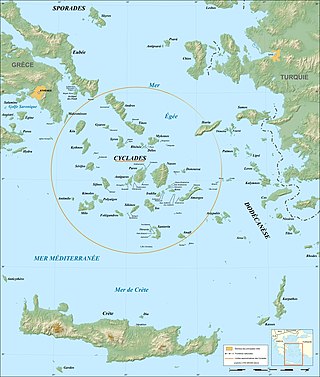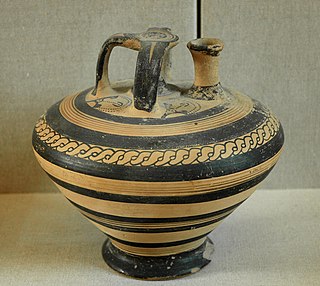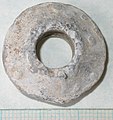
In archaeology, excavation is the exposure, processing and recording of archaeological remains. An excavation site or "dig" is the area being studied. These locations range from one to several areas at a time during a project and can be conducted over a few weeks to several years.

A metal detector is an instrument that detects the nearby presence of metal. Metal detectors are useful for finding metal objects on the surface, underground, and under water. A metal detector consists of a control box, an adjustable shaft, and a variable-shaped pickup coil. When the coil nears metal, the control box signals its presence with a tone, light, or needle movement. Signal intensity typically increases with proximity. A common type are stationary "walk through" metal detectors used at access points in prisons, courthouses, airports and psychiatric hospitals to detect concealed metal weapons on a person's body.

Cycladic culture was a Bronze Age culture found throughout the islands of the Cyclades in the Aegean Sea. In chronological terms, it is a relative dating system for artifacts which is roughly contemporary to Helladic chronology and Minoan chronology (Crete) during the same period of time.

An artifact or artefact is a general term for an item made or given shape by humans, such as a tool or a work of art, especially an object of archaeological interest. In archaeology, the word has become a term of particular nuance; it is defined as an object recovered by archaeological endeavor, including cultural artifacts.

Sanxingdui is an archaeological site and a major Bronze Age culture in modern Guanghan, Sichuan, China. Largely discovered in 1986, following a preliminary finding in 1927, archaeologists excavated artifacts that radiocarbon dating placed in the 12th-11th centuries BC. The archaeological site is the type site for the Sanxingdui culture that produced these artifacts, archeologists have identified the locale with the ancient kingdom of Shu. The artifacts are displayed in the Sanxingdui Museum located near the city of Guanghan.

Stratigraphy is a key concept to modern archaeological theory and practice. Modern excavation techniques are based on stratigraphic principles. The concept derives from the geological use of the idea that sedimentation takes place according to uniform principles. When archaeological finds are below the surface of the ground, the identification of the context of each find is vital in enabling the archaeologist to draw conclusions about the site and about the nature and date of its occupation. It is the archaeologist's role to attempt to discover what contexts exist and how they came to be created. Archaeological stratification or sequence is the dynamic superimposition of single units of stratigraphy, or contexts.
Absolute dating is the process of determining an age on a specified chronology in archaeology and geology. Some scientists prefer the terms chronometric or calendar dating, as use of the word "absolute" implies an unwarranted certainty of accuracy. Absolute dating provides a numerical age or range, in contrast with relative dating, which places events in order without any measure of the age between events.

The National Museum of Archaeology is a Maltese museum in Valletta, with artefacts from prehistory, Phoenician times and a notable numismatic collection. It is managed by Heritage Malta.

Alrø is a small Danish island in Horsens Fjord on the east coast of Jutland within Odder Municipality.The island is 7.52 km long with a coastline of 14 km, and stretches a little over 5 km wide from east to west. With a population of 147 as of January 2013, the island can be reached by road over an artificial causeway which connects it to the mainland on the northern side of the fjord. Alrø has been inhabited continuously since the Stone Age up to modern times, with possible additional usage during the Viking Age as a landing site.

Unguja Ukuu is a historic Swahili settlement on Unguja island, in Zanzibar, Tanzania.

Franktown Cave is located 25 miles (40 km) south of Denver, Colorado on the north edge of the Palmer Divide. It is the largest rock shelter documented on the Palmer Divide, which contains artifacts from many prehistoric cultures. Prehistoric hunter-gatherers occupied Franktown Cave intermittently for 8,000 years beginning about 6400 BC The site held remarkable lithic and ceramic artifacts, but it is better known for its perishable artifacts, including animal hides, wood, fiber and corn. Material goods were produced for their comfort, task-simplification and religious celebration. There is evidence of the site being a campsite or dwelling as recently as AD 1725.

The Ellerbusch site (12-W-56) is a small but significant archaeological site in the southwestern part of the U.S. state of Indiana. Unlike many sites created by people of the same culture, it occupies an upland site near a major river floodplain. Its existence appears to have been the result of the coincidence of periods of peace and growth in the related Angel site, which led some townspeople to leave their homes for new villages that were more convenient for resource gathering. Researched partly because of its small size, Ellerbusch has produced information that greatly increases present awareness of other small sites and of its culture's overall patterns of settlement in the region. Because of its archaeological value, the site was declared a historic site in the late twentieth century.

Songo Mnara is a historic Swahiili settlement in located on Songo Mnara Island in Pande Mikoma, Kilwa District in Lindi Region of Tanzania. The island is home to a Medieval Swahili stone town. The stone town was occupied from the 14th to 16th centuries. Songo Mnara has been recognized as a UNESCO World Heritage Site, along with nearby stone town Kilwa Kisiwani. In total, archaeologists have found six mosques, four cemeteries, and two dozen house blocks along with three enclosed open spaces on the island. Songo Mnara was constructed from rough-coral and mortar. This stonetown was built as one of many trade towns on the Indian Ocean. The site is a registered National Historic Site.

The Afyonkarahisar Archaeological Museum, also known as the Afyon Museum, is an archaeological museum in Afyonkarahisar, Turkey. It exhibits a wide variety of artifacts from the Copper Age, Bronze Age and the civilizations of Hittites, Phrygians, Ancient Greece and the Byzantine Empire.
This page is a glossary of archaeology, the study of the human past from material remains.

Keezhadi, or Keeladi, is a Sangam period settlement site, where excavation are carried out by the Archaeological Survey of India and the Tamil Nadu State Department of Archaeology. This site is located near the town of Keezhadi in Sivaganga district, Tamil Nadu, about 12 km southeast of Madurai. The settlement lies on the bank of the Vaigai River and it reflects the ancient culture of Tamil Nadu. Epigraphist V. Vedachalam, who served as a domain expert for the excavation, dated the excavated remains between 6th century BCE and 3rd century BCE.
The Huber Site (11Ck-1) is located on Tinley Creek 2 miles west of Blue Island in Cook County, Illinois, near the city of Chicago. It is classified as a late prehistoric site with Upper Mississippian affiliation.
The Hoxie Farm site (11Ck-4) is located on Thorn Creek in Thornton, Illinois Cook County Forest Preserve in Cook County, Illinois, near the city of Chicago. It is classified as a late prehistoric to Protohistoric/Early Historic site with Upper Mississippian Huber affiliation.
The Oak Forest Site (11Ck-53) is located in Oak Forest, Cook County, Illinois, near the city of Chicago. It is classified as a late prehistoric to Protohistoric/Early Historic site with Upper Mississippian Huber affiliation.
The Anker Site (11Ck-21) is located on the Little Calumet River near Chicago, Illinois. It is classified as a late prehistoric site with Upper Mississippian Huber affiliation.

















